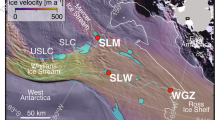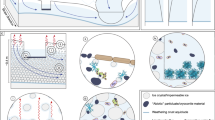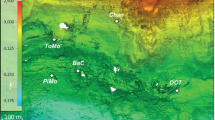Abstract
Microbial processes that mineralize organic carbon and enhance solute production at the bed of polar ice sheets could be of a magnitude sufficient to affect global elemental cycles. To investigate the biogeochemistry of a polar subglacial microbial ecosystem, we analyzed water discharged during the summer of 2012 and 2013 from Russell Glacier, a land-terminating outlet glacier at the western margin of the Greenland Ice Sheet. The molecular data implied that the most abundant and active component of the subglacial microbial community at these marginal locations were bacteria within the order Methylococcales (59–100% of reverse transcribed (RT)-rRNA sequences). mRNA transcripts of the particulate methane monooxygenase (pmoA) from these taxa were also detected, confirming that methanotrophic bacteria were functional members of this subglacial ecosystem. Dissolved methane ranged between 2.7 and 83 μM in the subglacial waters analyzed, and the concentration was inversely correlated with dissolved oxygen while positively correlated with electrical conductivity. Subglacial microbial methane production was supported by δ13C-CH4 values between −64‰ and −62‰ together with the recovery of RT-rRNA sequences that classified within the Methanosarcinales and Methanomicrobiales. Under aerobic conditions, >98% of the methane in the subglacial water was consumed over ∼30 days incubation at ∼4 °C and rates of methane oxidation were estimated at 0.32 μM per day. Our results support the occurrence of active methane cycling beneath this region of the Greenland Ice Sheet, where microbial communities poised in oxygenated subglacial drainage channels could serve as significant methane sinks.
Similar content being viewed by others
Log in or create a free account to read this content
Gain free access to this article, as well as selected content from this journal and more on nature.com
or
Accession codes
References
Aebly FA, Fritz SC . (2009). Palaeohydrology of Kangerlussuaq (Søndre Strømfjord), West Greenland during the last ∼8000 years. Holocene 19: 91–104.
Amaral JA, Knowles R . (1994). Methane metabolism in a temperate swamp. Appl Environ Microbiol 60: 3945–3951.
Amaral JA, Archambault C, Richards SR, Knowles R . (1995). Denitrification associated with Groups I and II methanotrophs in a gradient enrichment system. FEMS Microbiol Ecol 18: 289–298.
Bárcena TG, Yde JC, Finster KW . (2010). Methane flux and high-affinity methanotrophic diversity along the chronosequence of a receding glacier in Greenland. Ann Glaciol 51: 23–31.
Bates ST, Berg-Lyons D, Caporaso JG, Walters WA, Knight R, Fierer N . (2011). Examining the global distribution of dominant archaeal populations in soil. ISME J 5: 08–917.
Bell RE . (2008). The role of subglaical water in ice-sheet mass balance. Nat Geosci 1: 297–304.
Berestovskaya YY, Vasil'eva LV, Chestnykh OV, Zavarzin GA . (2002). Methanotrophs of the psychrophilic microbial community of the Russian Arctic Tundra. Microbiol 71: 538–544.
Blazewicz SJ, Barnard RL, Daly RA, Firestone MK . (2013). Evaluating rRNA as an indicator of microbial activity in environmental communities: limitations and uses. ISME J 7: 2061–2068.
Borrel G, Jézéquel D, Biderre-Petit C, Morel-Desrosiers N, Morel J-P, Peyret P et al. (2011). Production and consumption of methane in freshwater lake ecosystems. Res Microbiol 162: 832–847.
Boyd ES, Skidmore M, Mitchell AC, Bakermans C, Peters JW . (2010). Methanogenesis in subglacial sediments. Environ Microbiol Rep 2: 685–692.
Bräuer SL, Cadillo-Quiroz H, Ward RJ, Yavitt JB, Zinder SH . (2011). Methanoregula boonei gen. nov., sp. nov., an acidiphilic methanogen isolated from an acidic peat bog. Int J Syst Evol Microbiol 61: 45–52.
Broemsen ELJE . (2013). Evidence of methane cycling beneath the western margin of the Greenland Ice Sheet. Master's Thesis. Louisiana State University. http://etd.lsu.edu/docs/available/etd-01142014-185208/.
Cameron KA, Hodson AJ, Osborn AM . (2012). Structure and diversity of bacterial, eukaryotic and archaeal communities in glacial cryoconite holes from the Arctic and the Antarctic. FEMS Microbiol Ecol 82: 254–267.
Carini S, Bano N, LeCleir G, Joye SB . (2005). Aerobic methane oxidation and methanotroph community composition during seasonal stratification in Mono Lake, California (USA). Environ Microbiol 7: 127–1138.
Campbell BJ, Yu L, Heidelberg JF, Kirchman DL . (2011). Activity of abundant and rare bacteria in a coastal ocean. Proc Natl Acad Sci USA 108: 12776–112781.
Chandler DM, Wadham JL, Lis GP, Cowton T, Sole A, Bartholomew I et al. (2013). Evolution of the subglacial drainage system beneath the Greenland Ice Sheet revealed by tracers. Nat Geosci 6: 195–198.
Christner BC, Mosley-Thompson E, Thompson LG, Reeve JN . (2001). Isolation of bacteria and 16S rDNAs from Lake Vostok accretion ice. Environ Microbiol 3: 570–577.
Christner BC, Montross GG, Priscu JC . (2012). Dissolved gases in frozen basal water from the NGRIP borehole: implications for biogeochemical processes beneath the Greenland ice sheet. Polar Biol 35: 1735–1741.
Degelmann DM, Borken W, Drake HL, Kolb S . (2010). Different atmospheric methane-oxidizing communities in European beech and Norway spruce soils. Appl Environ Microbiol 76: 3228–3235.
Devol AH, Richey JE, Clark WA, King SL, Martinelli LA . (1988). Methane emissions to the troposphere from the Amazon floodplain. J Geophys Res Atmos 93: 1583–1592.
Fitzpatrick AAW, Hubbard A, Joughin I, Quincey DJ, van As D, Mikkelsen APB et al. (2013). Ice flow dynamics and surface meltwater flux at a land-terminating sector of the Greenland ice sheet. J Glaciol 59: 687–696.
Hamilton TL, Peters JW, Skidmore ML, Boyd ES . (2013). Molecular evidence for an active endogenous microbiome beneath glacial ice. ISME J 7: 1402–1412.
Hewitt IJ . (2011). Modelling distributed and channelized subglacial drainage: the spacing of channels. J Glaciol 57: 302–314.
Hobbs WH . (1927). The first Greenland expedition of the University of Michigan. Geographical Rev 17: 1–35 American Geographical Society of New York.
Irvine-Fynn TDL, Edwards A, Newton S, Langford H, Rassner SM, Telling J et al. (2012). Microbial cell budgets of an Arctic glacier surface quantified using flow cytometry. Environ Microbiol 14: 2998–3012.
Kelley C . (2003). Methane oxidation potential in the water column of two diverse coastal marine sites. Biogeochemistry 65: 05–120.
Knight PG, Waller RI, Patterson CJ, Jones AP, Robinson ZP . (2000). Glacier advance, ice-marginal lakes and routing of meltwater and sediment: Russell Glacier, Greenland. J Glaciol 46: 423–426.
Lanoil B, Skidmore M, Priscu JC, Han S, Foo W, Vogel SW et al. (2009). Bacteria beneath the West Antarctic Ice Sheet. Environ Microbiol 11: 609–615.
Lawson EC, Wadham JL, Tranter M, Stibal M, Lis GP, Butler CEH et al. (2013). Greenland Ice Sheet exports labile organic carbon to the Arctic oceans. Biogeosci Discuss 10: 19311–19345.
Liebner S, Rublack K, Stuehrmann T, Wagner D . (2009). Diversity of aerobic methanotrophic bacteria in a permafrost active layer soil of the Lena Delta, Siberia. Microb Ecol 57: 25–35.
Lofton DD, Whalen SC, Hershey AE . (2014). Effect of temperature on methane dynamics and evaluation of methane oxidation kinetics in shallow Arctic Alaskan lakes. Hydrobiology 721: 209–222.
Martineau C, Whyte LG, Greer CW . (2010). Stable isotope probing analysis of the diversity and activity of methanotrophic bacteria in soils from the Canadian High Arctic. Appl Environ Microbiol 76: 5773–5784.
Mayborn KR, Lesher CE . (2006). Origin and evolution of the Kangâmiut mafic dyke swarm, West Greenland. GEUS 11: 61–86.
McMillan M, Nienow P, Shepherd A, Benham T, Sole A . (2007). Seasonal evolution of supra-glacial lakes on the Greenland Ice Sheet. Earth Planet Sci Lett 262: 484–492.
Miteva V, Teacher C, Sowers T, Brenchley J . (2009). Comparison of the microbial diversity at different depths of the GISP2 Greenland ice core in relationship to deposition climates. Environ Microbiol 11: 640–656.
Mohanty SR, Bodelier PLE, Conrad R . (2007). Effect of temperature on composition of the methanotrophic community in rice field and forest soil. FEMS Microbiol Ecol 62: 24–31.
Nghiem SV, Hall DK, Mote TL, Tedesco M, Albert MR, Keegan K et al. (2012). The extreme melt across the Greenland ice sheet in 2012. Geophys Res Lett 39: L20502.
Schloss PD, Westcott SL, Ryabin T, Hall JR, Hartmann M, Hollister EB et al. (2009). Introducing mothur: open-source, platform-independent, community-supported software for describing and comparing microbial communities. Appl Environ Microbiol 75: 7537–7541.
Singh N, Kendall MM, Liu Y, Boone DR . (2005). Isolation and characterization of methylotrophic methanogens from anoxic marine sediments in Skan Bay, Alaska: description of Methanococcoides alaskense sp. nov., and emended description of Methanosarcina baltica. Int J Syst Evol Microbiol 55: 2531–2538.
Skidmore M, Anderson SP, Sharp M, Foght J, Lanoil BD . (2005). Comparison of microbial community compositions of two subglacial environments reveals a possible role for microbes in chemical weathering processes. Appl Environ Microbiol 71: 6986–6997.
Skidmore M, Tranter M, Tulaczyk S, Lanoil B . (2010). Hydrochemistry of ice stream beds-evaporitic or microbial effects? Hydrol Process 24: 517–523.
Souchez R, Lemmens M, Chappellaz J . (1995). Flow-induced mixing in the GRIP basal ice deduced from the CO2 and CH4 records. Geophys Res Lett 22: 41–44.
Souchez R, Jouzel J, Landais A, Chappellaz J, Lorrain R, Tison JL . (2006). Gas isotopes in ice reveal a vegetated central Greenland during ice sheet invasion. Geophys Res Lett 33: L24503.
Stibal M, Lawson EC, Lis GP, Mak KM, Wadham JL, Anesio AM . (2010). Organic matter content and quality in supraglacial debris across the ablation zone of the Greenland Ice Sheet. Ann Glaciol 51: 1–8.
Stibal M, Hasan F, Wadham JL, Sharp MJ, Anesio AM . (2012a). Prokaryotic diversity in sediments beneath two polar glaciers with contrasting organic carbon substrates. Extremophiles 16: 255–265.
Stibal M, Wadham JL, Lis GP, Telling J, Pancost RD, Dubnick A et al. (2012b). Methanogenic potential of Arctic and Antarctic subglacial environments with contrasting organic carbon sources. Global Change Biol 18: 3332–3345.
Stibal M, Šabacká M, Žárský J . (2012c). Biological processes on glacier and ice sheet surfaces. Nat Geosci 5: 771–774.
Strous M . (2010). Global consequences of anaerobic methane oxidation. In: Timmis KN, (ed) Handbook of Hydrocarbon and Lipid Microbiology. Springer: Berlin Heidelberg, pp 3077–3085.
Tedstone AJ, Nienow PW, Sole AJ, Mair DWF, Cowton TR, Bartholomew ID et al. (2013). Greenland ice sheet motion insensitive to exceptional meltwater forcing. Proc Natl Acad Sci USA 49: 19719–19724.
Telling J, Stibal M, Anesio AM, Tranter M, Nias I, Cook J et al. (2012). Microbial nitrogen cycling on the Greenland Ice Sheet. Biogeoscience 9: 2431–2442.
Tranter M, Skidmore M, Wadham J . (2005). Hydrological controls on microbial communities in subglacial environments. Hydrol Process 19: 995–998.
Walter Anthony KM, Anthony P, Grosse G, Chanton J . (2012). Geologic methane seeps along boundaries of Arctic permafrost thaw and melting glaciers. Nat Geosci 5: 419–426.
Wadham JL, Tranter M, Tulaczyk S, Sharp M . (2008). Subglacial methanogenesis: a potential climatic amplifier? Global Biogeochem Cycles 22: 1–16.
Wadham JL, Arndt S, Tulaczyk S, Stibal M, Tranter M, Telling J et al. (2012). Potential methane reservoirs beneath Antarctica. Nature 488: 633–637.
Whiticar J . (1999). Carbon and hydrogen isotope systematics of bacterial formation and oxidation of methane. Chem Geol 161: 291–314.
Yde JC, Finster KW, Raiswell R, Steffensen JP, Heinemeier J, Olsen J et al. (2010). Basal ice microbiology at the margin of the Greenland ice sheet. Ann Glaciol 51: 71–79.
Acknowledgements
This collaborative study was funded by National Science Foundation grants (1023462, 1023233 and 1023351) from the Division of Polar Programs. BCC and AMA were also partially supported by funds from NSF award 0838941 and the NSF’s Graduate Research Fellowship Program (1247192), respectively. Logistical support was provided by Polar Field Services and Kangerlussuaq International Science Support. We thank L Liu, Z Harrold, S Foredyce and S Schoenemann for assistance in the field.
Author information
Authors and Affiliations
Corresponding author
Ethics declarations
Competing interests
The authors declare no conflict of interest.
Additional information
Supplementary Information accompanies this paper on The ISME Journal website
Supplementary information
Rights and permissions
About this article
Cite this article
Dieser, M., Broemsen, E., Cameron, K. et al. Molecular and biogeochemical evidence for methane cycling beneath the western margin of the Greenland Ice Sheet. ISME J 8, 2305–2316 (2014). https://doi.org/10.1038/ismej.2014.59
Received:
Revised:
Accepted:
Published:
Issue date:
DOI: https://doi.org/10.1038/ismej.2014.59
Keywords
This article is cited by
-
Thermal acclimation of methanotrophs from the genus Methylobacter
The ISME Journal (2023)
-
Methylotrophic Communities Associated with a Greenland Ice Sheet Methane Release Hotspot
Microbial Ecology (2023)
-
Biogeochemical and historical drivers of microbial community composition and structure in sediments from Mercer Subglacial Lake, West Antarctica
ISME Communications (2023)
-
Subglacial lakes and their changing role in a warming climate
Nature Reviews Earth & Environment (2022)
-
Microdiversity characterizes prevalent phylogenetic clades in the glacier-fed stream microbiome
The ISME Journal (2022)



